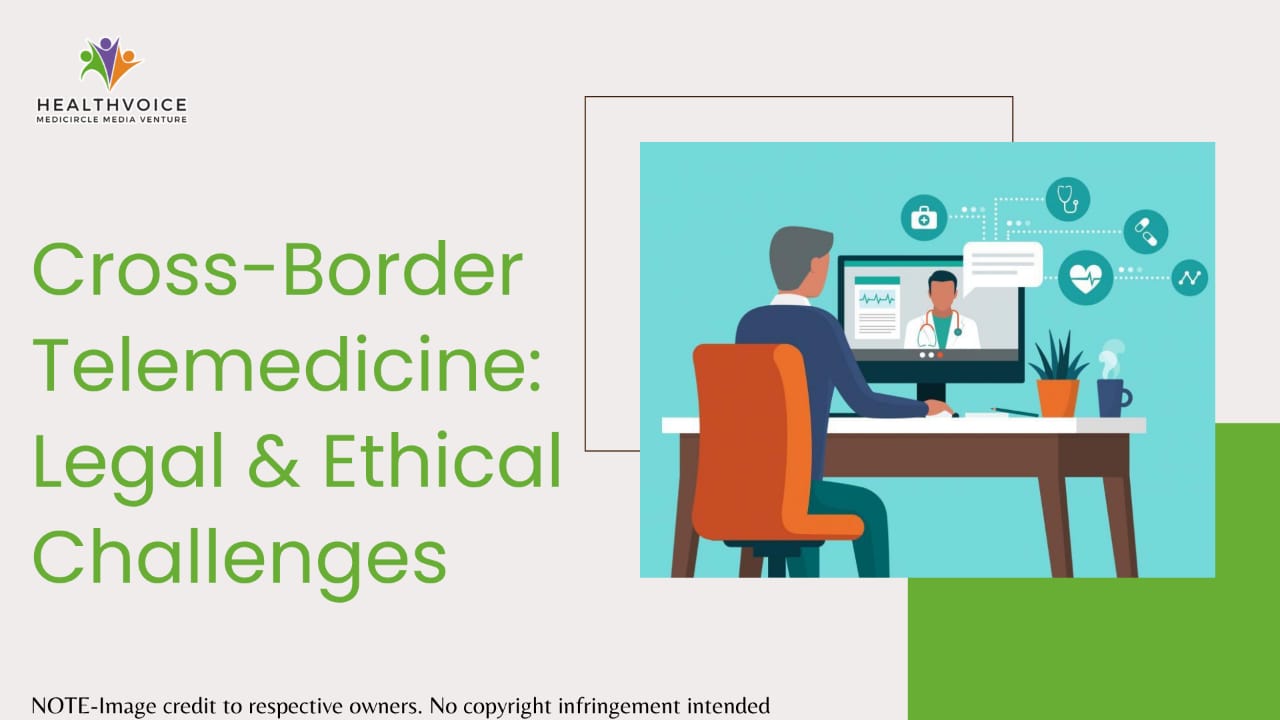Cross-Border Telemedicine: Legal & Ethical Challenges
Cross-border telemedicine connects doctors and patients beyond borders but faces complex legal, ethical and technological challenges in India. Addressing jurisdiction, licensing, liability and patient trust is crucial for its responsible growth.

Geography has always been a barrier to good healthcare. A family in a remote village often travels hours to a city, hoping to see a specialist. But what if the specialist could come to them, not in person, but through a screen? This is the powerful promise of cross-border telemedicine. It is a field changing how doctors and patients connect across state and national lines. Yet, as this digital bridge expands, it is built on a complex foundation of legal puzzles and ethical dilemmas that India must now solve.
This is not just about technology; it is about trust, responsibility and ensuring that the human element of healing is not lost in digital translation.
The legal maze:
The moment a digital consultation crosses a border, it steps into a legal grey area. The rules that govern a clinic in one place may not neatly apply to a video call that spans continents.
- Question of jurisdiction:
Consider a scenario where a surgeon in Germany remotely assists in a procedure on a patient in Kerala. If a complication arises, which country’s courts handle the matter? Does German law apply or Indian? This ambiguity creates a significant challenge. Within India itself, each state has its own medical council regulations. A doctor licensed in Maharashtra is not automatically licensed to practice in Tamil Nadu, even digitally. This patchwork of rules becomes a major hurdle for seamless care.
- The licensing puzzle:
In traditional medicine, a doctor’s license is tied to a specific location. Telemedicine shatters this model. Should a brilliant oncologist in Delhi need separate certifications to advise a patient in Dubai or Delhi via a digital platform? The current answer is often yes, creating a web of bureaucratic red tape that can block timely expert care. Some countries are experimenting with mutual recognition agreements, but a global standard is still a distant dream.
- Liability in a digital world:
Technical glitches are a reality of digital life. But what happens when a video call freezes during a critical consultation or a robotic surgical system experiences a lag? Who is responsible; the doctor, the hospital that hired them or the company that built the software? Traditional medical malpractice laws are not fully equipped to handle these scenarios. The lines of accountability are blurred, leaving both patients and providers in a vulnerable position.
Core legal hurdles:
- Whose law rules: Unclear jurisdiction can lead to legal deadlock and make doctors hesitant to offer cross-border services.
- The license barrier: The need for multiple licenses limits the pool of available specialists and can drive up costs.
- The blame game: Unclear liability for tech failures creates risks for patient safety and complicates insurance.
- Data in different lands: Complying with varying data privacy laws like India’s new Digital Personal Data Protection Act, is a major operational challenge.
Ethical dilemmas:
Beyond the legal fine print lie deeper ethical questions that strike at the core of patient care.
Privacy in a pixelated world: A doctor’s clinic is a private space. A digital platform however, can be vulnerable. Patients rightly worry: who else can access their sensitive medical history during a tele-consultation? Ensuring that digital platforms have robust, end to end encryption is no longer a luxury; it is a fundamental requirement for building patient trust.
Bridging the digital divide: Telemedicine aims to democratize healthcare, but it risks creating a new kind of inequality. Can a farmer in a village with poor internet connectivity benefit? What about an elderly person unfamiliar with smartphone apps? If we are not careful, telemedicine could become a privilege for the urban and tech savvy, leaving behind those who need it most.
Preserving the human connection: A large part of diagnosis comes from a doctor’s keen observation; a subtle tremor, a slight change in skin color. Can a screen fully capture these nuances? Studies suggest that misdiagnosis is a leading cause of telemedicine malpractice claims, often because the digital window offers a limited view. Doctors must now learn to compensate for this limitation, using technology without letting it diminish their clinical intuition and empathetic touch.
India’s path forward:
The challenges are real, but they are not insurmountable. With a thoughtful and collaborative approach, India can become a global leader in responsible telemedicine.
- Clear national guidelines: India needs a standardized framework for cross-border telemedicine that clarifies jurisdiction and simplifies licensing. Learning from models like the Interstate Medical Licensure Compact in the United States could provide a useful starting point.
- Smarter, safer tech: Technology must be both advanced and accessible. The rollout of 5G can solve critical issues like lag during remote procedures. Simultaneously, investing in user friendly apps for rural populations and ensuring military grade data security must be parallel priorities.
- Global partnerships: As seen in collaborations between the Telemedicine Society of India and other international bodies, sharing knowledge is key. By working with other nations, India can help develop shared standards for global digital health.
- Design for everyone: From the beginning, digital health solutions must be inclusive. This means creating systems that work with low bandwidth in local languages and with intuitive designs for users of all ages and technical abilities.
A final thought:
The journey of cross-border telemedicine is just beginning. Its success will not be measured by the sophistication of its technology, but by its ability to deliver compassionate, equitable and trustworthy care. It requires doctors, policymakers, tech developers and patients to come together in an ongoing conversation.
The goal is to use the digital world not to replace the vital human connection in healing, but to extend its reach further than ever before. For a country as vast and diverse as India, getting this balance right could mean a healthier future for millions.
#DigitalHealth #Telemedicine #HealthTech #GlobalHealthcare #Telehealth #FutureOfMedicine #DigitalTransformation #HealthcareInnovation #MedTech #CrossBorderCare #RemoteHealthcare #HealthForAll #DataPrivacy #EthicalAI #SmartHealthcare #HealthcarePolicy #HealthEquity #IndianHealthcare #VirtualCare #ConnectedHealth #healthvoice
